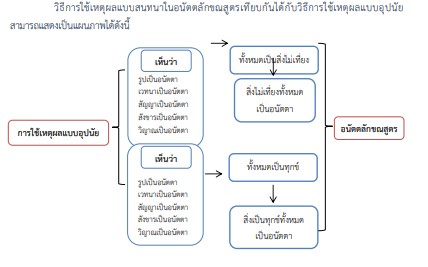Reasoning in Anattalakkhana Sutta
Main Article Content
Abstract
The Anattalakkhaṇa Sutta is the second sutra that the Lord Buddha taught to the Panchavaggi at Isipattana Maruegathayawan Forest, Varanasi, on the waning day of the 5th day of the 8th lunar month. The essence of the Anattalakkhaṇa Sutta is to point out the impermanence of all things, showing that form, sensation, perception, body and consciousness or the five aggregates are impermanent, suffering, and subject to change. It should not be seen primarily with lust, mana, view that this is mine, this is me, this is my identity.
In reasoning in the Anattalakkhaṇa Sutta, the Buddha used two types of principles and methods of reasoning: The first type is a deductive reasoning method. By using the topic of Dhamma Let's set it up as a topic for use in explaining.. After that, it was explained so that the listeners would understand that all these dharmas were non-self. In the end, it concluded that These dharmas are anatta. The second type is an inductive reasoning method, which is to take the Dhamma topics of form, feeling, perception, mental formations, and consciousness as a leading question. When the listener answers how it is, that answer will be used as the next question. To lead to the destination that the Lord Buddha wanted. When the listener understands what the Buddha has presented Finally, he concludes by asking questions to get the listeners to accept that reason.
Article Details

This work is licensed under a Creative Commons Attribution-NonCommercial-NoDerivatives 4.0 International License.
เรื่องลิขสิทธิ์/เป็นความคิดเห็นของผู้เขียน
References
หนังสือ:
คณาจารย์. (2555). มหาวิทยาลัยมหาจุฬาลงกรณราชวิทยาลัย. ตรรกศาสตร์เบื้องต้น. กรุงเทพมหานคร: โรงพิมพ์มหาจุฬาลงกรณราชวิทยาลัย.
บารมี. (2550). พระพุทธเจ้าองค์ใหม่ที่จะตรัสรู้ต่อจาก “เจ้าชายสิทธัตถะ”. กรุงเทพมหานคร: โรงพิมพ์มหา-
มกุฏราชวิทยาลัย.
พระธรรมปิฎก (ป.อ.ปยุตฺโต). 2543). ไตรลักษณ์. พิมพ์ครั้งที่ 3. กรุงเทพมหานคร: มูลนิธิพุทธธรรม.
พระพรหมคุณาภรณ์ (ป.อ.ปยุตฺโต). (2551). พจนานุกรมพุทธศาสน์ ฉบับประมวลศัพท์. พิมพ์ครั้งที่ 12.
กรุงเทพมหานคร: โรงพิมพ์มหาจุฬาลงกรณราชวิทยาลัย.
พระพุทธโฆษาจารย์. (2550). พระวิสุทธิมรรค เล่มเดียวจบ. มหาวงศ์ ชาญบาลี ชำระและตรวจสอบ.
กรุงเทพมหานคร: โรงพิมพ์ธรรมบรรณาคาร (อำนวยสาส์น).
พุทธทาสภิกขุ. (2545) ชีวิตคือขันธ์ 5. กรุงเทพมหานคร: ธรรมสภา.
พุทธทาสภิกขุ (เงื่อม อินฺทปญฺโญ). (2533). ธรรมโฆษณ์อรรถานุกรม. กรุงเทพมหานคร: สวนกุหลาบมูลนิธิ.
มหาจุฬาลงกรณราชวิทยาลัย. (2560). พระไตรปิฎกภาษาไทย ฉบับมหาจุฬาลงกรณราชวิทยาลัย.
กรุงเทพมหานคร: โรงพิมพ์มหาจุฬาลงกรณราชวิทยาลัย.
มหาจุฬาลงกรณราชวิทยาลัย. (2506). พระไตรปิฎกภาษาบาลี ฉบับมหาจุฬาลงเตปิฏกํ. กรุงเทพมหานคร:
โรงพิมพ์รุ่งเรืองธรรม.
สมเด็จพระญาณสังวร สมเด็จพระสังฆราช สกลมหาสังฆปริณายก. (2551). 45 พรรษาของพระพุทธเจ้า. กรุงเทพมหาคร : มหามกุฏราชวิทยาลัย.
รายงานวิจัย
ประพันธ์ ศุภษร และสมควร นิยมวงศ์. (2551). “การวิเคราะห์ใช้เหตุผลในพระไตรปิฎก”. รายงานการวิจัย,
บัณฑิตวิทยาลัย มหาวิทาลัยมหาจุฬาลงกรณราชวิทยาลัย.


